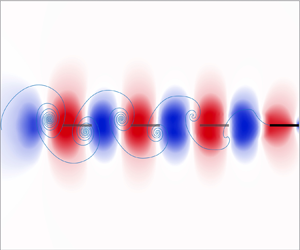Article contents
School cohesion, speed and efficiency are modulated by the swimmers flapping motion
Published online by Cambridge University Press: 13 July 2021
Abstract

Fish schools are ubiquitous in marine life. Although flow interactions are thought to be beneficial for schooling, their exact effects on the speed, energetics and stability of the group remain elusive. Recent numerical simulations and experimental models suggest that flow interactions stabilize in-tandem formations of flapping foils. Here, we employ a minimal vortex sheet model that captures salient features of the flow interactions among flapping swimmers, and we study the free swimming of a pair of in-line swimmers driven with identical heaving or pitching motions. We find that, independent of the flapping mode, heaving or pitching, the follower passively stabilizes at discrete locations in the wake of the leader, consistent with the heaving foil experiments, but pitching swimmers exhibit tighter and more cohesive formations. Further, in comparison to swimming alone, pitching motions increase the energetic efficiency of the group while heaving motions result in a slight increase in the swimming speed. A deeper analysis of the wake of a single swimmer sheds light on the hydrodynamic mechanisms underlying pairwise formations. These results recapitulate that flow interactions provide a passive mechanism that promotes school cohesion, and afford novel insights into the role of the flapping mode in controlling the emergent properties of the school.
- Type
- JFM Papers
- Information
- Copyright
- © The Author(s), 2021. Published by Cambridge University Press
References
REFERENCES
- 14
- Cited by



